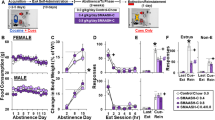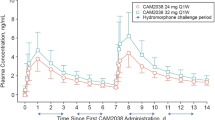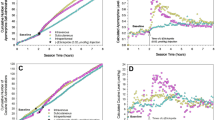Abstract
The aim of this study was to determine whether oral sustained release d-amphetamine (SR-AMP) reduces cocaine and opioid/cocaine combination (‘speedball’-like) seeking in volunteers with current opioid dependence and cocaine dependence. Following outpatient buprenorphine (BUP) 8 mg/day stabilization without SR-AMP, eight participants completed a 3-week in-patient study with continued BUP 8 mg/day maintenance and double-blind ascending SR-AMP weekly doses of 0, 30, and 60 mg/day, respectively. After 3 days (Saturday–Monday) stabilization at each SR-AMP weekly dose (0, 15, or 30 mg administered at 0700 and 1225 each day), on Tuesday–Friday mornings (0900–1200 hours), participants sampled four drug combinations in randomized, counterbalanced order under double-blind, double-dummy (intranasal cocaine and intramuscular hydromorphone) conditions: cocaine (COC 100 mg+saline); hydromorphone (COC 4 mg+HYD 24 mg); ‘speedball’ (COC 100 mg+HYD 24 mg); and placebo (COC 4 mg+saline). Subjective and physiological effects of these drug combinations were measured. From 1230 to 1530 hours, participants could respond on a choice, 12-trial progressive ratio schedule to earn drug units (1/12th of total morning dose) or money units (US$2). SR-AMP significantly reduced COC, but not HYD or speedball, choices and breakpoints. SR-AMP also significantly reduced COC subjective (eg, abuse-related) effects and did not potentiate COC-induced cardiovascular responses. This study shows the ability of SR-AMP to attenuate COC self-administration, as well as its selectivity, in cocaine/heroin polydrug abusers. Further research is warranted to ascertain whether SR-AMP combined with BUP could be a useful dual-agonist pharmacotherapy.
Similar content being viewed by others
Log in or create a free account to read this content
Gain free access to this article, as well as selected content from this journal and more on nature.com
or
References
Anderson AL, Reid MS, Li S-H, Holmes T, Shemanski L, Slee A et al (2009). Modafinil for the treatment of cocaine dependence. Drug Alcohol Depend 104: 133–139.
Bach MV, Coutts RT, Baker GB (1999). Involvement of CYP2D6 in the in vitro metabolism of amphetamine, two N-alkylamphetamines and their 4-methoxylated derivatives. Xenobiotica 29: 719–732.
Barrett AC, Miller JR, Dohrmann JM, Caine SB (2004). Effects of dopamine indirect agonists and selective D1-like and D2-like agonists and antagonists on cocaine self-administration and food maintained responding in rats. Neuropharmacology 47 (Supp1): 256–273.
Beck AT, Steer RA, Ball R, Rainieri W (1996). Comparison of Beck Depression Inventories-IA and -II in psychiatric outpatients. J Pers Assess 67: 588–597.
Beswick T, Best D, Rees S, Coomber R, Gossup M, Strang J (2001). Multiple drug use: patterns and practices of heroin and crack use in a population of opiate addicts in treatment. Drug Alcohol Rev 20: 201–204.
Castells X, Casas M, Vidal X, Bosch R, Roncero C, Antoni J et al (2007). Efficacy of central nervous system stimulant treatment for cocaine dependence: a systematic review and meta-analysis of randomized controlled clinical trials. Addiction 102: 1871–1887.
Chiodo KA, Läck CM, Roberts DCS (2008). Cocaine self-administration reinforced on a progressive ratio schedule decreases with continuous d-amphetamine treatment in rats. Psychopharmacology 200: 465–473.
Chiodo KA, Roberts DCS (2009). Decreased reinforcing effects of cocaine following 2 weeks of continuous d-amphetamine treatment in rats. Psychopharmacology 206: 447–456.
Comer SD, Ashworth JB, Foltin RW, Johanson CE, Zacny JP, Walsh SL (2008). The role of human drug self-administration procedures in the development of medications. Drug Alcohol Depend 96: 1–15.
Comer SD, Walker EA, Collins ED (2005). Buprenorphine/naloxone reduces the reinforcing and subjective effects of heroin in heroin-dependent volunteers. Psychopharmacology 181: 664–675.
Cornish JL, Lontos JM, Clemens KJ, McGregor IS (2005). Cocaine and heroin (‘speedball’) self-administration: the involvement of nucleus accumbens dopamine and μ-opiate, but not δ-opiate receptors. Psychopharmacology 180: 21–32.
Craddock SG, Rounds-Bryant JL, Flynn PM, Hubbard RL (1997). Characteristics and pretreatment behaviors of clients entering drug abuse treatment: 1969 to 1993. Am J Drug Alcohol Abuse 23: 43–59.
Cross JC, Johnson BD, Davis WR, Liberty HJ (2001). Supporting the habit: income generation activities of frequent crack users compared with frequent users of other hard drugs. Drug Alcohol Depend 64: 191–201.
Dackis CA, Kampman KM, Lynch KG, Pettinati HM, O’Brien CP (2005). A double-blind, placebo-controlled trial of modafinil for cocaine dependence. Neuropsychopharmacology 30: 205–211.
DeMaria Jr PA, Sterling R, Weinstein SP (2000). The effect of stimulant and sedative use on treatment outcome of patients admitted to methadone maintenance treatment. Am J Addict 9: 145–153.
Downey KK, Helmus TC, Schuster CR (2000). Treatment of heroin-dependent polydrug abusers with contingency management and buprenorphine maintenance. Exp Clin Psychopharmacol 8: 176–184.
Duvauchelle CL, Sapoznik T, Kornetsky C (1998). The synergistic effects of combining cocaine and heroin (‘speedball’) using a progressive-ratio schedule of drug reinforcement. Pharmacol Biochem Behav 61: 297–302.
First MB, Spitzer RL, Gibbon M, Williams JBW (1996). Structured Clinical Interview for DSM-IV Axis Disorders—Patient Edition (SCID-I/P, Version 20). Biometrics Research Dept., NY State Psychiatric Institute: New York.
Foltin RW, Evans SM (1999). The effects of d-amphetamine on intake of food and a sweet fluid containing cocaine. Pharmacol Biochem Behav 62: 457–464.
Ginovart N, Farde L, Halldin C, Swahn CG (1999). Changes in striatal D2-receptor density following chronic treatment with amphetamine as assessed with PET in nonhuman primates. Synapse 31: 154–162.
Glowa JR, Wojnicki FHE, Matecka D, Rice KC, Rothman RB (1995). Effects of dopamine reuptake inhibitors on food- and cocaine-maintained responding: II. Comparisons with other drugs and repeated administrations. Exp Clin Psychopharmacol 3: 232–239.
Gorelick DA, Gardner EL, Xi ZX (2004). Agents in development for the management of cocaine abuse. Drugs 64: 1547–1573.
Grabowski J, Rhoades H, Schmitz J, Stotts A, Daruzska LA, Creson D et al (2001). Dextroamphetamine for cocaine dependence treatment: a double-blind randomized clinical trial. J Clin Psychopharmacol 21: 522–526.
Grabowski J, Rhoades H, Stotts A, Cowan K, Kopecky C, Dougherty A et al (2004a). Agonist-like or antagonist-like treatment for cocaine dependence with methadone for heroin dependence: two double-blind randomized clinical trials. Neuropsychopharmacology 29: 969–981.
Grabowski J, Shearer J, Merrill J, Negus SS (2004b). Agonist-like replacement pharmacotherapy for stimulant abuse and dependence. Addict Behav 29: 1439–1464.
Green CE, LeValley SE, Tyson CA (1986). Comparison of amphetamine metabolism using isolated hepatocytes from five species including human. J Pharmacol Exp Ther 237: 931–936.
Greenwald MK (2010). Effects of experimental unemployment, employment and punishment analogs on opioid seeking and consumption in heroin-dependent volunteers. Drug Alcohol Depend 111: 64–73.
Greenwald MK, Hursh SR (2006). Behavioral economic analysis of opioid consumption in heroin-dependent individuals: effects of unit price and pre-session drug supply. Drug Alcohol Depend 85: 35–48.
Greenwald MK, Schuh KJ, Hopper JA, Schuster CR, Johanson CE (2002). Effects of buprenorphine sublingual tablet maintenance on opioid drug-seeking behavior by humans. Psychopharmacology 160: 344–352.
Greenwald MK, Steinmiller CL (2009). Behavioral economic analysis of opioid consumption in heroin-dependent individuals: effects of alternative reinforcer magnitude and post-session drug supply. Drug Alcohol Depend 104: 84–93.
Grella CE, Anglin MD, Wugalter SE (1995). Cocaine and crack use and HIV risk behaviors among high-risk methadone maintenance clients. Drug Alcohol Depend 37: 15–21.
Griffiths RR, Troisi JR, Silverman K, Mumford GK (1993). Multiple-choice procedure: an efficient approach for investigating drug reinforcement in humans. Behav Pharmacol 4: 3–13.
Haney M, Spealman R (2008). Controversies in translational research: drug self-administration. Psychopharmacology 199: 403–419.
Hart CL, Haney M, Vosburg SK, Rubin E, Foltin RW (2008). Smoked cocaine self-administration is decreased by modafinil. Neuropsychopharmacology 33: 761–768.
Herin DV, Rush CR, Grabowski J (2010). Agonist-like pharmacotherapy for stimulant dependence: preclinical, human laboratory, and clinical studies. Ann N Y Acad Sci 1187: 76–100.
Hudgins R, McCusker J, Stoddard A (1995). Cocaine use and risky injection and sexual behaviors. Drug Alcohol Depend 37: 7–14.
Jasinski DR (1977). Assessment of the abuse potentiality of morphine-like drugs (methods used in man). In: Martin WR (ed). Handbook of Experimental Pharmacology. Springer-Verlag: Heidelberg, West Germany. pp 197–258.
Johns MW (1991). A new method for measuring daytime sleepiness: the Epworth Sleepiness Scale. Sleep 14: 540–545.
Kampman KM, Volpicelli JR, McGinnis DE, Alterman AI, Weinrieb RM, D’Angelo L et al (1998). Reliability and validity of the Cocaine Selective Severity Assessment. Addict Behav 23: 449–461.
Kim JH, Perugini M, Austin JD, Vezina P (2001). Previous exposure to amphetamine enhances the subsequent locomotor response to a D1 dopamine receptor agonist when glutamate reuptake is inhibited. J Neurosci 21: RC133.
King VL, Kidorf MS, Stoller KB, Carter JA, Brooner RK (2001). Influence of antisocial personality subtypes on drug abuse treatment response. J Nerv Ment Dis 189: 593–601.
Kleinknecht RA, Kleinknecht EE, Sawchuck CN, Lee T, Lohr JM (1999). Medical Fear Survey: psychometric properties. Behav Therapist 22: 109–119.
Kobayashi K, Yamamoto T, Chiba K, Tani M, Shimada N, Ishizaki T et al (1998). Human buprenorphine N-dealkylation is catalyzed by cytochrome P450 3A4. Drug Metab Dispos 26: 818–821.
Kreek MJ (2000). Methadone-related opioid agonist pharmacotherapy for heroin addiction. History, recent molecular and neurochemical research and future in mainstream medicine. Ann N Y Acad Sci 909: 186–216.
Leri F, Bruneau J, Stewart J (2004). Understanding polydrug use: review of heroin and cocaine co-use. Addiction 98: 7–22.
Li Y, Kauer JA (2004). Repeated exposure to amphetamine disrupts dopaminergic modulation of excitatory synaptic plasticity and neurotransmission in nucleus accumbens. Synapse 51: 1–10.
Lynch WJ, Heaser WA, Carroll ME (1998). Effects of amphetamine, butorphanol, and morphine pretreatment on the maintenance and reinstatement of cocaine-reinforced responding. Exp Clin Psychopharmacol 6: 255–263.
Magura S, Siddiqi Q, Freeman RC, Lipton DS (1991). Changes in cocaine use after entry to methadone treatment. J Addict Dis 10: 31–45.
Mansbach RS, Balster RL (1993). Effects of mazindol on behavior maintained or occasioned by cocaine. Drug Alcohol Depend 31: 183–191.
Martin WR, Sloan JW, Sapiro JD, Jasinski DR (1971). Physiologic, subjective, and behavioral effects of amphetamine, methamphetamine, ephedrine, phenmetrazine, and methylphenidate in man. Clin Pharmacol Ther 12: 245–258.
Mello NK, Negus SS (1998). The effects of buprenorphine on self-administration of cocaine and heroin ‘speedball’ combinations and heroin alone by rhesus monkeys. J Pharmacol Exp Ther 295: 444–456.
Mello NK, Negus SS (2007). Effects of d-amphetamine and buprenorphine combinations on speedball (cocaine+heroin) self-administration by rhesus monkeys. Neuropsychopharmacology 32: 1985–1994.
Mello NK, Negus SS, Lukas SE, Mendelson JH, Sholar JW, Drieze J (1995). A primate model of polydrug abuse: cocaine and heroin combinations. Pharmacol Exp Ther 274: 1325–1337.
Montoya ID, Gorelick DA, Preston KL, Schroeder JR, Umbricht A, Cheskin LJ et al (2004). Randomized trial of buprenorphine for treatment of concurrent opiate and cocaine dependence. Clin Pharmacol Ther 75: 34–48.
Moody DE, Slawson MH, Strain EC, Laycock JD, Spanbauer AC, Foltz RL (2002). A liquid chromatographic-electrospray ionization-tandem mass spectrometric method for determination of buprenorphine, its metabolite, norbuprenorphine, and a coformulant, naloxone, that is suitable for in vivo and in vitro metabolism studies. Anal Biochem 306: 31–39.
Negus SS (2003). Rapid assessment of choice between cocaine and food in rhesus monkeys: effects of environmental manipulations and treatment with d-amphetamine and flupenthixol. Neuropsychopharmacology 28: 919–931.
Negus SS (2005). Interactions between the reinforcing effects of cocaine and heroin in a drug-vs-food choice procedure in rhesus monkeys: a dose-addition analysis. Psychopharmacology 180: 115–124.
Negus SS, Mello NK (2003a). Effects of chronic d-amphetamine treatment on cocaine- and food-maintained responding under a second-order schedule in rhesus monkeys. Drug Alcohol Depend 70: 39–52.
Negus SS, Mello NK (2003b). Effects of chronic d-amphetamine treatment on cocaine- and food-maintained responding under a progressive-ratio schedule in rhesus monkeys. Psychopharmacology 167: 324–332.
Office of National Drug Control Policy (ONDCP) (2003). Economic Costs of Drug Aabuse in the United States: 1992–2002.
Peltier RL, Li DH, Lytle D, Taylor CM, Emmett-Oglesby MW (1996). Chronic d-amphetamine or methamphetamine produces cross-tolerance to the discriminative and reinforcing stimulus effects of cocaine. J Pharmacol Exp Ther 277: 212–218.
Perez DLC, Trujols J, Ribalta E, Casas M (1997). Cocaine use immediately prior to entry in an inpatient heroin detoxification unit as a predictor of discharges against medical advice. Am J Drug Alcohol Abuse 23: 267–269.
Preston KL, Silverman K, Higgins ST, Brooner RK, Montoya I, Schuster CR et al (1998). Cocaine use early in treatment predicts outcome in a behavioral treatment program. J Consult Clin Psychol 66: 691–696.
Rothman RB, Blough BE, Baumann MH (2002). Appetite suppressants as agonist substitution therapies for stimulant dependence. Ann N Y Acad Sci 965: 109–126.
Rowlett JK, Rodefer JS, Spealman RD (2005). Self-administration of cocaine-opioid combinations by rhesus monkeys: evaluation of the role of mu receptor efficacy using labor supply analysis. J Pharmacol Exp Ther 312: 1289–1297.
Rowlett JK, Wilcox KM, Woolverton WL (1998). Self-administration of cocaine-heroin combinations by rhesus monkeys: antagonism by naltrexone. J Pharmacol Exp Ther 286: 61–69.
Rowlett JK, Woolverton WL (1997). Self-administration of cocaine and heroin combinations by rhesus monkeys responding under a progressive-ratio schedule. Psychopharmacology 133: 363–371.
Rush CR, Baker RW, Wright K (1999). Acute physiological and behavioral effects of oral cocaine in humans: a dose–response analysis. Drug Alcohol Depend 55: 1–12.
Rush CR, Stoops WW, Hays LR (2009). Cocaine effects during d-amphetamine maintenance: a human laboratory analysis of safety, tolerability and efficacy. Drug Alcohol Depend 99: 261–271.
Rush CR, Stoops WW, Sevak RJ, Hays LR (2010). Cocaine choice in humans during d-amphetamine maintenance. J Clin Psychopharmacol 30: 152–159.
Schottenfeld RS, Pakes J, Ziedonis D, Kosten TR (1993). Buprenorphine: dose-related effects on cocaine and opioid use in cocaine-abusing opioid-dependent humans. Biol Psychiatry 34: 66–74.
Schuster CR, Greenwald MK, Johanson CE, Heishman SJ (1995). Measurement of drug craving during naloxone-precipitated withdrawal in methadone maintained volunteers. Exp Clin Psychopharmacol 3: 424–431.
Schütz CG, Vlahov D, Anthony JC, Graham NMH (1994). Comparison of self-reported injection frequencies for past 30 days and 6 months among intravenous drug users. J Clin Epidemiol 47: 191–195.
Shearer J, Gowing LR (2004). Pharmacotherapies for problematic psychostimulant use: a review of current research. Drug Alcohol Rev 23: 203–211.
Sofuoglu M, Gonzalez G, Poling J, Kosten TR (2003). Prediction of treatment outcome by baseline urine cocaine results and self-reported cocaine use for cocaine and opioid dependence. Am J Drug Alcohol Abuse 29: 713–727.
Strug DL, Hunt DE, Goldsmith DS, Lipton DS, Spunt B (1985). Patterns of cocaine use among methadone clients. Int J Addict 20: 1163–1175.
Sussner BD, Smelson DA, Rodrigues S, Kline A, Losonczy M, Ziedonis D (2006). The validity and reliability of a brief measure of cocaine craving. Drug Alcohol Depend 83: 233–237.
Tiffany ST, Singleton E, Haertzen CA, Henningfield JE (1993). The development of a cocaine craving questionnaire. Drug Alcohol Depend 34: 19–28.
Tomkins DM, Otten SV, Joharchi N, Berns T, Wu D, Corrigal WA et al (1997). Effect of CYP2D1 inhibition on the behavioural effects of d-amphetamine. Behav Pharmacol 8: 223–235.
Torrens M, San L, Peri JM, Olle JM (1991). Cocaine abuse among heroin addicts in Spain. Drug Alcohol Depend 27: 29–34.
Tzilos GK, Rhodes GL, Ledgerwood DM, Greenwald MK (2009). Predicting cocaine group treatment outcome in cocaine-abusing methadone-maintained patients. Exp Clin Psychopharmacol 17: 320–325.
Umehara K, Shimokawa Y, Miyamoto G (2002). Inhibition of human drug metabolizing cytochrome P450 by buprenorphine. Biol Pharm Bull 25: 682–685.
Winger G, Galuska CM, Hursh SR, Woods JH (2006). Relative reinforcing effects of cocaine, remifentanil, and their combination in rhesus monkeys. J Pharmacol Exp Ther 318: 223–229.
Woolverton WL, Wang Z, Vasterling T, Tallarida R (2008). Self-administration of cocaine–remifentanil mixtures by monkeys: an isobolographic analysis. Psychopharmacology 198: 387–394.
Zachary RA (1991). Shipley Institute of Living Scale: Revised Manual. Western Psychological Services: Los Angeles, CA.
Zhang W, Ramamoorthy Y, Tyndale RF, Sellers EM (2003). Interaction of buprenorphine and its metabolite norbuprenorphine with cytochromes p450 in vitro. Drug Metab Dispos 31: 768–772.
Acknowledgements
NIH Grant R01 DA022243 from the National Institute on Drug Abuse and a research grant (Joe Young, Sr. funds) from the State of Michigan supported this research. This study was registered as NIH Clinical Trial NCT00429767 (http://clinicaltrials.gov/ct2/show/NCT00429767). We thank Dr Chris-Ellyn Johanson for consultation, Dr Carl Christensen for medical oversight, Ken Bates for recruitment, and Debra Kish, Joi Moore, and Lisa Sulkowski for data collection and management. We thank the staff of the Psychiatric and Addiction Research Center at Wayne State University for clinical data collection and safety monitoring.
Author information
Authors and Affiliations
Corresponding author
Ethics declarations
Competing interests
The authors declare no conflicts of interest in relationship to performing this study. Dr Greenwald has received compensation as a consultant to Reckitt-Benckiser Pharmaceuticals, the company that markets the buprenorphine products, Suboxone and Subutex. Both Dr Greenwald and Dr Steinmiller have received compensation from Titan Pharmaceuticals. Dr Lundahl has received compensation from Gateway Community Health (Michigan), and the National Football League.
Rights and permissions
About this article
Cite this article
Greenwald, M., Lundahl, L. & Steinmiller, C. Sustained Release d-Amphetamine Reduces Cocaine but not ‘Speedball’-Seeking in Buprenorphine-Maintained Volunteers: A Test of Dual-Agonist Pharmacotherapy for Cocaine/Heroin Polydrug Abusers. Neuropsychopharmacol 35, 2624–2637 (2010). https://doi.org/10.1038/npp.2010.175
Received:
Revised:
Accepted:
Published:
Issue date:
DOI: https://doi.org/10.1038/npp.2010.175
Keywords
This article is cited by
-
D-amphetamine maintenance therapy reduces cocaine use in female rats
Psychopharmacology (2022)
-
Amphetamine maintenance therapy during intermittent cocaine self-administration in rats attenuates psychomotor and dopamine sensitization and reduces addiction-like behavior
Neuropsychopharmacology (2021)
-
Influence of phendimetrazine maintenance on the reinforcing, subjective, performance, and physiological effects of intranasal cocaine
Psychopharmacology (2019)
-
Effects of methamphetamine isomers on d-methamphetamine self-administration and food-maintained responding in male rats
Psychopharmacology (2019)
-
Amphetamine maintenance differentially modulates effects of cocaine, methylenedioxypyrovalerone (MDPV), and methamphetamine on intracranial self-stimulation and nucleus accumbens dopamine in rats
Neuropsychopharmacology (2018)



